 Nevermind a treehouse, this blog has photographs of a hut made from living trees. They look like some kind of ficus to me. If you look at the detail images, you'll see how the trunks have knitted together- those columns you can see are 'woven' from stems.
Nevermind a treehouse, this blog has photographs of a hut made from living trees. They look like some kind of ficus to me. If you look at the detail images, you'll see how the trunks have knitted together- those columns you can see are 'woven' from stems.
bridges
(18)
campsite
(28)
cartoons
(15)
centenary
(3)
discussion
(5)
experimental
(51)
gadgets
(23)
gateways
(12)
lashings
(21)
models
(9)
raft
(84)
resources
(27)
sculpture
(16)
software
(22)
techniques
(42)
towers
(45)
trebuchets
(5)
treehouses
(17)
tutorial
(9)
March 29, 2006
Treehouse, no wait... House tree?
 Nevermind a treehouse, this blog has photographs of a hut made from living trees. They look like some kind of ficus to me. If you look at the detail images, you'll see how the trunks have knitted together- those columns you can see are 'woven' from stems.
Nevermind a treehouse, this blog has photographs of a hut made from living trees. They look like some kind of ficus to me. If you look at the detail images, you'll see how the trunks have knitted together- those columns you can see are 'woven' from stems.
March 28, 2006
3d Software for Scout Pioneering
 There have been a couple of questions recently about the software I use to make the drawings on this site.
There have been a couple of questions recently about the software I use to make the drawings on this site. The 3d program I use is called SketchUp, it is unbelievably fast and pretty simple to use in comparison to other 3d software. Recently, the company was purchased by Google. You can download a trial version here, this will run for 8 hours of use- enough time for you to learn the software and build some fairly detailed models (a typical drawing for this site will take me about 15 to 20 minutes). To get a feel for how it works, watch the video tutorials before opening it up and building a computer model of your own pioneering project...
March 26, 2006
Hebrew-English translator sought
An anonymous message on my Israeli super-pioneering post has given me some very intriguing links, this time with in-depth explanations. Unfortunately, I can't read Hebrew, and can't find a decent on-line translating service. If you speak Hebrew (and especially if you are scout) and have a little time to help me translate these pages, please let me know. Thanks.
Kontiki 2006 - Some Rafts
A Kontiki report back should probably include some reference to the rafts at some point :) These are a couple I snapped while doing water patrol on sunday morning.
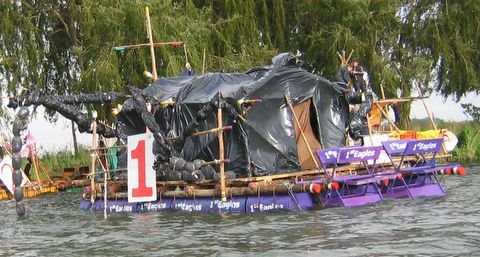 Team 1, First Eagles, with an Acromantula. Legs are made from 2 litre plastic bottles wrapped in black plastic bags.
Team 1, First Eagles, with an Acromantula. Legs are made from 2 litre plastic bottles wrapped in black plastic bags.
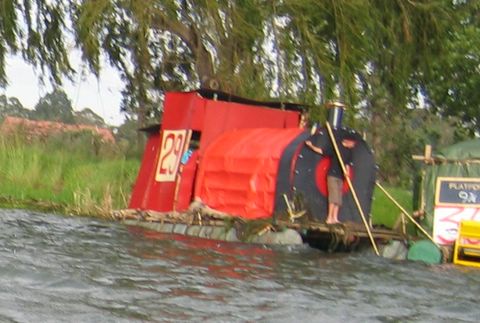 Team 29 (1st Kengray)with a Hogwart's Express train. Nice piece of pioneering work- if you look you can see the laths supporting the decorations on the side.
Team 29 (1st Kengray)with a Hogwart's Express train. Nice piece of pioneering work- if you look you can see the laths supporting the decorations on the side.
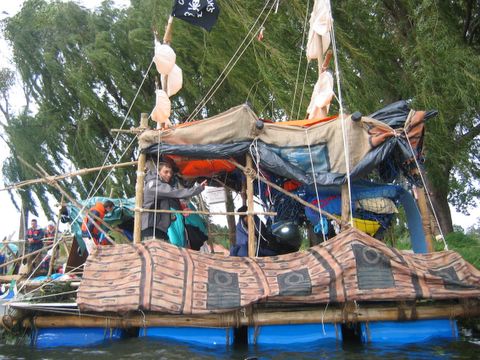 Departing from the Harry Potter theme of the other rafts is this Pirates of the Caribbean ship. Raft number is obscured so I can't say who this was, possibly 9th Irene.
Departing from the Harry Potter theme of the other rafts is this Pirates of the Caribbean ship. Raft number is obscured so I can't say who this was, possibly 9th Irene.
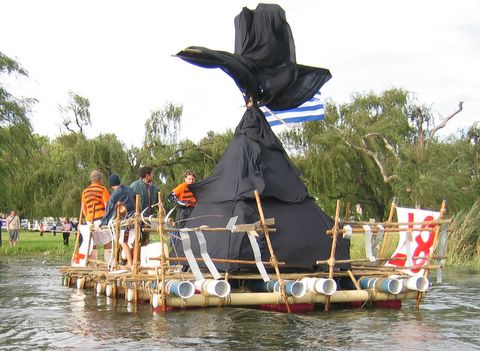
 1st Hellenic have hidden their tent inside the sorting hat on this raft, but what I'm really interested in is not the decoration, but the construction material they have chosen: instead of eucalyptus poles, the most common pioneering material in South Africa, they have used PVC drainage pipes- see the detail photo. I imagine there are pretty good weight savings to be made using this material. I'm going to try and find out some more about their success with pipes for pioneering structures... watch this space.
1st Hellenic have hidden their tent inside the sorting hat on this raft, but what I'm really interested in is not the decoration, but the construction material they have chosen: instead of eucalyptus poles, the most common pioneering material in South Africa, they have used PVC drainage pipes- see the detail photo. I imagine there are pretty good weight savings to be made using this material. I'm going to try and find out some more about their success with pipes for pioneering structures... watch this space.
 Team 1, First Eagles, with an Acromantula. Legs are made from 2 litre plastic bottles wrapped in black plastic bags.
Team 1, First Eagles, with an Acromantula. Legs are made from 2 litre plastic bottles wrapped in black plastic bags. Team 29 (1st Kengray)with a Hogwart's Express train. Nice piece of pioneering work- if you look you can see the laths supporting the decorations on the side.
Team 29 (1st Kengray)with a Hogwart's Express train. Nice piece of pioneering work- if you look you can see the laths supporting the decorations on the side. Departing from the Harry Potter theme of the other rafts is this Pirates of the Caribbean ship. Raft number is obscured so I can't say who this was, possibly 9th Irene.
Departing from the Harry Potter theme of the other rafts is this Pirates of the Caribbean ship. Raft number is obscured so I can't say who this was, possibly 9th Irene.
 1st Hellenic have hidden their tent inside the sorting hat on this raft, but what I'm really interested in is not the decoration, but the construction material they have chosen: instead of eucalyptus poles, the most common pioneering material in South Africa, they have used PVC drainage pipes- see the detail photo. I imagine there are pretty good weight savings to be made using this material. I'm going to try and find out some more about their success with pipes for pioneering structures... watch this space.
1st Hellenic have hidden their tent inside the sorting hat on this raft, but what I'm really interested in is not the decoration, but the construction material they have chosen: instead of eucalyptus poles, the most common pioneering material in South Africa, they have used PVC drainage pipes- see the detail photo. I imagine there are pretty good weight savings to be made using this material. I'm going to try and find out some more about their success with pipes for pioneering structures... watch this space.
March 23, 2006
Friction-lock table- one-rope pioneering
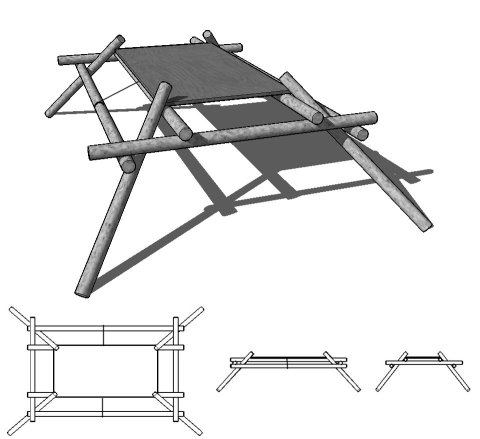 More reporting from Kontiki- Marc spotted this table at Kontiki, which has been built quite ingeniously. Friction locks the whole table together. There is one rope stopping the entire thing from spreading out and falling apart, running across the table (from left to right,under the table top). No lashings are used at all in this construction.
More reporting from Kontiki- Marc spotted this table at Kontiki, which has been built quite ingeniously. Friction locks the whole table together. There is one rope stopping the entire thing from spreading out and falling apart, running across the table (from left to right,under the table top). No lashings are used at all in this construction. The original table was made (I think) by 1st Greenside scout troop- if you can confirm this or correct it, please leave a comment for me here. From the photo, I am unable to tell whether the legs are splayed out or parallel to each other, in the drawings above I have made them splayed so that they lock the table-top down.
The original table was made (I think) by 1st Greenside scout troop- if you can confirm this or correct it, please leave a comment for me here. From the photo, I am unable to tell whether the legs are splayed out or parallel to each other, in the drawings above I have made them splayed so that they lock the table-top down. I imagine that it would be built like this: lay out 4 parallel poles (the ones pointing towards the screen in the drawing and photograph) and tie together (with clove hitches on each pole).
Lift the 2 centre poles you have just tied, place the two cross-poles under these but over the outside poles.
Place table top in centre of table.
Lift table (by the two outside tied poles) and hold up (2 scouts) while the legs are inserted.
Once again, I'd love to hear from the builders of this table, and know how they actually did it.
March 16, 2006
Downloadable pioneering book
 Clarke at Scoutmaster blog has put together a great book with pioneering drawings and explanations that you can download as a PDF here. Based on the requirements for the Boy Scouts of America's pioneering merit badge, it covers all of the basics of general pioneering, and is definitely worth looking at. Take a look at the Knots and Pioneering category on Scoutmaster blog here.
Clarke at Scoutmaster blog has put together a great book with pioneering drawings and explanations that you can download as a PDF here. Based on the requirements for the Boy Scouts of America's pioneering merit badge, it covers all of the basics of general pioneering, and is definitely worth looking at. Take a look at the Knots and Pioneering category on Scoutmaster blog here.
March 13, 2006
Step-By-Step Tensegrity Tower
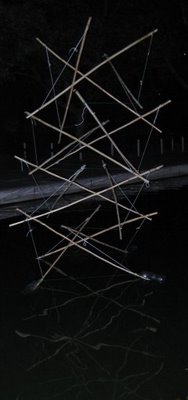 This series runs through the theoretical and practical aspects of building a tensegrity tower
This series runs through the theoretical and practical aspects of building a tensegrity tower
Part 1 : Introduction
Part 2 : Drawings and discussion
Part 3 : Building a model
Part 4 : Assembling the full-size tower
Part 5 : Completing and installing the tower
Links
-Wikipedia article on Tensegrity
-Tensegrity website with photographs and links
-Shelter systems, a company making tensegrity tents.
-Tensegrity model built for Burning Man.
-Tensegrity shade tent, also built for Burning Man.
-Kenneth Snelson's homepage (Snelson invented tensegrity structures)
-Wikipedia article on Kenneth Snelson
-Tensegrity cube kit (sponsored Amazon link)
Subscribe to:
Posts (Atom)
